Home > Highlighting JAPAN > Highlighting Japan MARCH 2011 > The 14th Japan Media Arts Festival
Highlighting JAPAN
TOPICS

Caption: Art Division Grand Prize: Cycloïd-E by Michel Décosterd/André Décosterd
Credit: TADASHI AIZAWA
The 14th Japan Media Arts Festival

The exhibition of the 14th Japan Media Arts Festival at the National Art Center in Roppongi, Tokyo
Credit: TADASHI AIZAWA

Entertainment Division Excellence Prize: echochrome ii by Ken Suzuta/Jun Fujiki/Tatsuya Suzuki (display for the Playstation game)
Credit: ©2010 SONY COMPUTER ENTERTAIMENT INC.
Cycloïd-E by Michel Décosterd/André Décosterd (Switzerland), which was awarded the Grand Prize in the Art Division, is an installation composed of five metal tubes each one meter in length, which move in an irregular way, with sound resonating in four directions from speakers attached to the ends of the tubes in sync with this motion. It is an enormous installation, with the overall diameter of movement of the arms reaching 10 meters. The jury gave the following comments in respect of this work.

Animation Division Grand Prize: The Tatami Galaxy by Masaaki Yuasa
Credit: ©THE TATAMI GALAXY COMMITTEE
In the Entertainment Division, many works use analog motifs that are somehow nostalgic, such as shadow and paper cutting. echochrome ii (Ken Suzuta/Jun Fujiki/Tatsuya Suzuki), winner of the Excellence Prize, is an action puzzle game inspired by the theme of light and shadows. Using the controller as a flashlight, players freely manipulate the shape of shadows toward the ultimate goal.
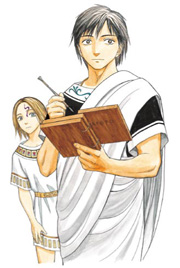
Manga Division Grand Prize: Historie by Hitoshi Iwaaki
Credit: ©HITOSHI IWAAKI/KODANSHA
In the Manga Division, works were selected from a variety of artists, from veterans to younger artists. Prominent among these were works that were based on historical fact while at the same time reconstructing those facts in an original way and in the distinctive style of the author, such as the Grand Prize winner Historie (Hitoshi Iwaaki), a historical manga set in the Ancient Orient, and Red (Naoki Yamamoto), a multiprotagonist drama about young student revolutionaries. At the awards ceremony, winner of the Grand Prize Hitoshi Iwaaki commented, "The Media Arts Festival has an extremely advanced image, but the drawing of manga itself is an unsophisticated task using pen and paper. I want to remember this feeling as I continue to draw in the future."
Yoshiyuki Kurihara was awarded the Special Achievement Prize for his involvement in editing Shonen Magazine since the 1970s, and his services to international cultural exchange by introducing overseas writers to Japan. In his address at the awards ceremony, Kurihara said, "Japanese manga flowered all at once in the postwar years of high economic growth [late 1950s–1970s], and I believe that it has now entered its adolescence in the true sense. I often speak with writers overseas, and they say that the characteristic of Japanese manga is an awareness of how frames connect. Japanese manga evolved by discovering the appeal of the frame. We should continue to value that inherent characteristic."
Words with the Winners
The Japan Media Arts Festival awards one Grand Prize, four Excellence Prizes and one Encouragement Prize in recognition of works of outstanding artistry and creativity in the four divisions of Art, Entertainment, Animation and Manga. Shin Sakurai interviews two of the winners in the 2010 (14th) Festival.
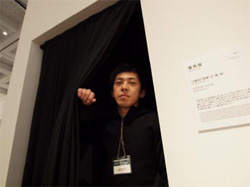
Ryota Kuwakubo in the doorway to his installation
Credit: TADASHI AIZAWA
In a darkroom-like space, a model train with a light bulb attached to the front slowly navigates through various household objects such as clothes pegs and baskets. The shadows of the objects are projected on the walls, floor and ceiling, and keep changing like the scenery seen through a carriage window. Ryota Kuwakubo, who has presented media art using electronics in Japan and overseas, has succeeded in creating a captivating work that produces "a personal experience" for all who see it.
It could be seen as a work that evokes the nostalgia of traveling in the past, or a futuristic image, but where did the concept come from?
Ryota Kuwakubo: I think many people made shadow pictures when they were children… It originated in the simple idea of what would happen if you saw shadows objectively, disconnected from your hands. It was difficult to create a simulation of what to place where in relation to the model train railway track to get the shadows I wanted, so I made it at the site by actually putting things in place.
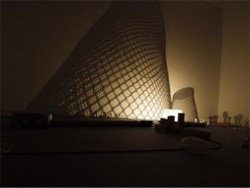
"The Tenth Sentiment"
Credit: TADASHI AIZAWA
"The Tenth Sentiment" is different from what we normally understand by interactive artworks, isn't it?
Yes, because the viewer does not move, but simply looks at the work. However, what happens is that while they are looking, some kind of interaction occurs inside the viewer.
I wonder if the reason you used an analog flavor such as this is because with progress in digital technology, interactive has become the norm?
Technically speaking, I think it would have been possible to make this thirty years or more ago, but thirty years ago there was probably no one who wanted to make it. As media have evolved, so people's sensibilities have been renewed, so that the traditional technique of shadow play once again seems like something new, perhaps. The exhibition space setting has been darkened to the point that people's faces are invisible, so the viewer's experience of it is totally individual. Even I don't know what image is created in the mind of the viewer. Someone came and told me about the scenery they had once seen while traveling, which makes me very happy. This year, exhibitions have been planned at three overseas locations. Who knows, there may be viewers who look at it in the context of the Japanese culture of mitate [seeing an object, not in the form that was originally intended for it, but as another thing] or shakkei [borrowed scenery]. I am looking forward to their reactions.
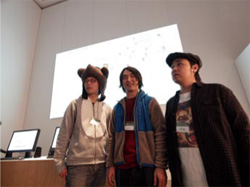
IS Parade creators (from left) Tomohiko Koyama, Tomohiko Hayashi, Kensuke Senbo
Credit: TADASHI AIZAWA
When Twitter users register their ID with IS Parade, the icons of their followers turn into characters with arms and legs, who parade with the user at the center. Created as a promotion for smartphones, 13.5 million parades were generated during the approximately six months between 30 April and 15 November, 2010. It has been tweeted to prominent figures in Japan and overseas, including Biz Stone, the co-founder and creative director of Twitter, and the parade seems likely to continue. Web planner Tomohiko Hayashi, the key member of the creation team, says, "I would like to design new networking communication [tools]."
You normally work in an advertising agency, so would it be correct to understand this work too as part of an advertisement ordered by a client?
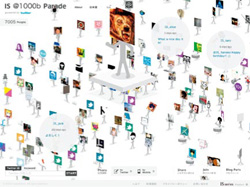
IS Parade
Credit: ©KDDI CORPORATION. All rights reserved.
Was the decision to have Twitter followers turning into characters and parading easy?
It was decided at a relatively early stage. It is an unmistakable fact that relationships between people and communication styles have changed with the spread of smartphones and Twitter. In this context, I thought about what would make the users of this technology happy, what they would enjoy. People who use Twitter will understand what I mean when I say that they get pleasure simply from seeing their followers grow in number. When I expressed this in a visual form, this was the result. With your own icon, your alter ego, at the center, the icons of your followers carry you in a portable shrine, and parade with musical instruments playing around you. I wondered if, by visualizing online connections in three-dimensional form, I could express the fun and pleasure of connections with other people. The fact that this kind of design for the purpose of communication is also recognized as art perhaps symbolizes the current times.
© 2009 Cabinet Office, Government of Japan






